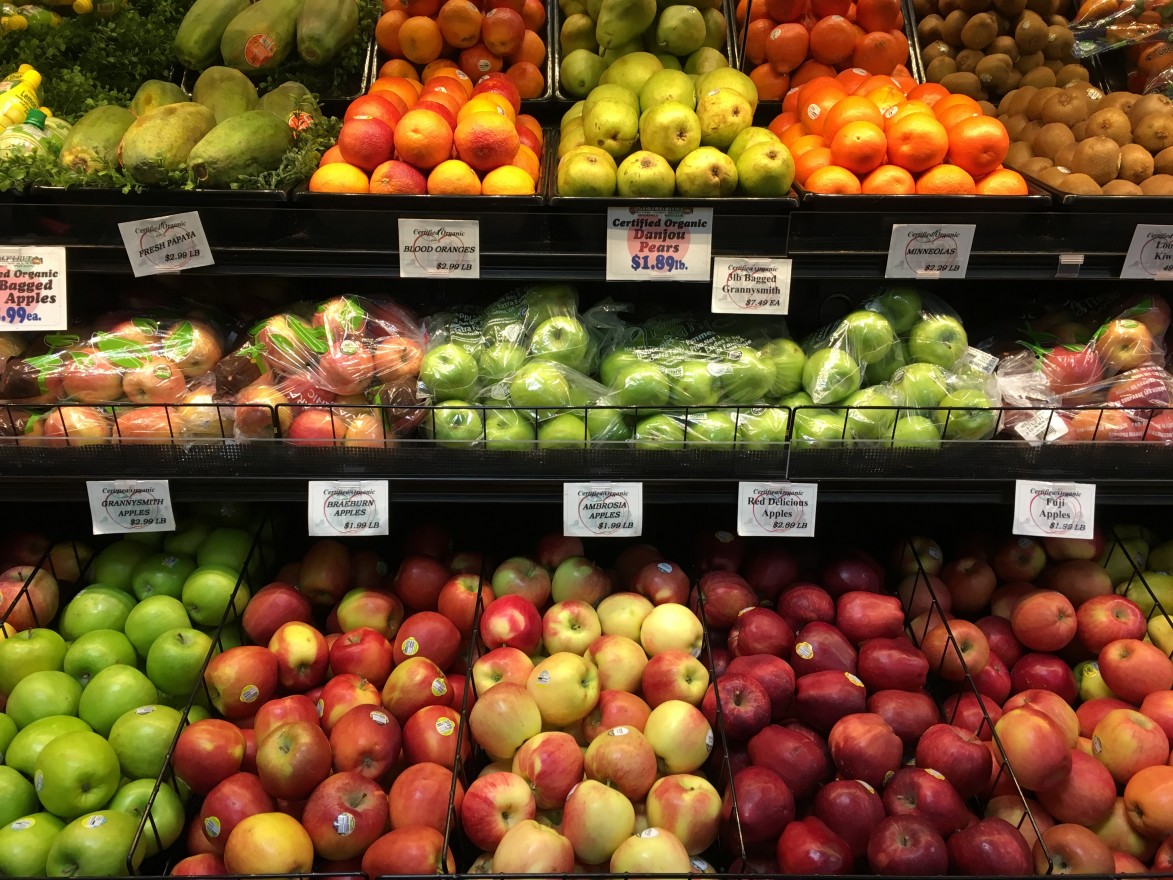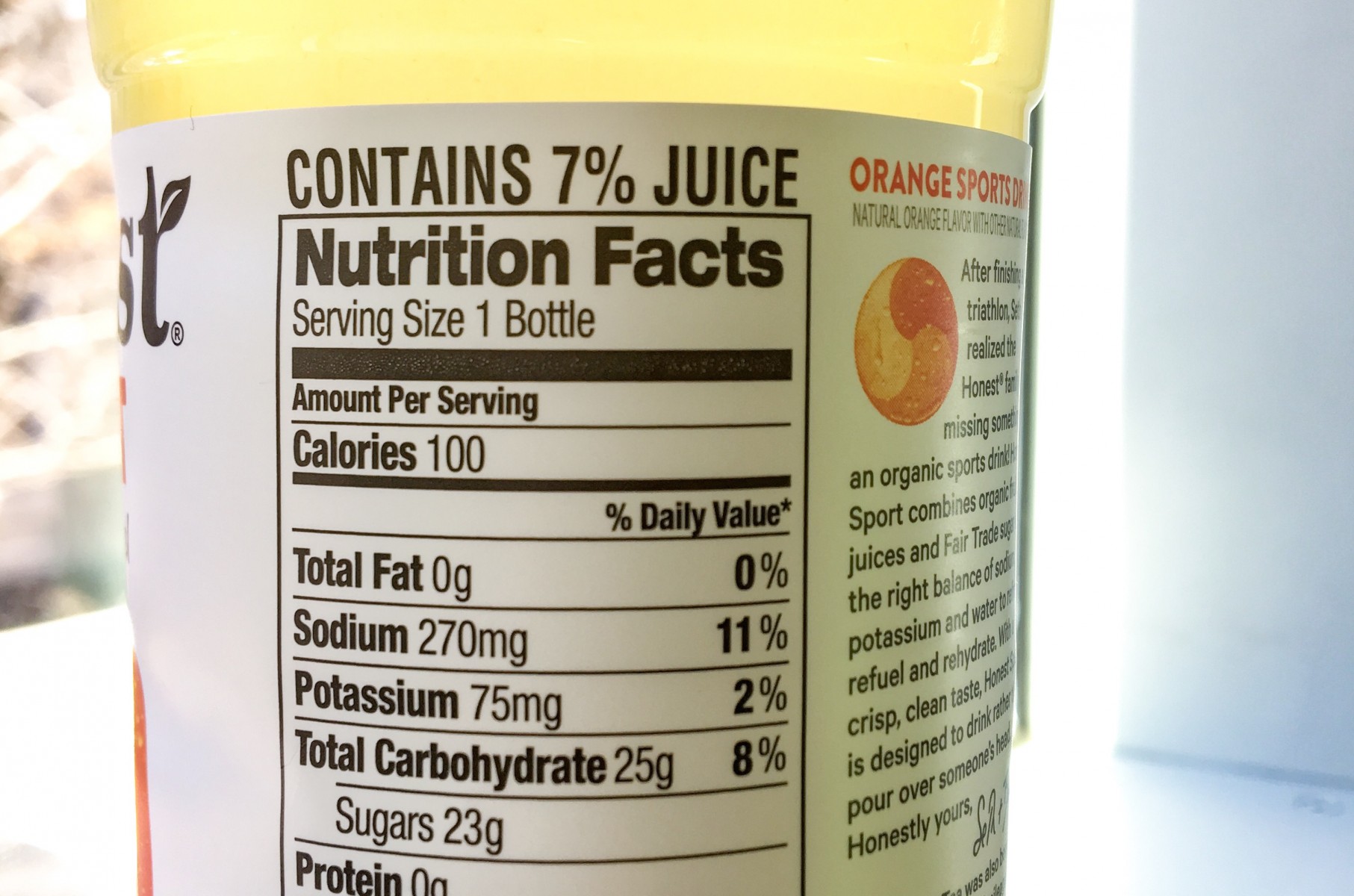
Could produce and packaged food be labeled with carbon data in the future? (Katherine Baker/Columbia University)

Could produce and packaged food be labeled with carbon data in the future? (Katherine Baker/Columbia University)
The food system emits up to one-third of global greenhouse gas emissions. Between cultivation, processing, shipping, storing, and disposal, food production is a climate-costly part of modern society. Many believe that limiting the carbon emissions produced by the food system is paramount in limiting climate change.
But how, exactly, to go about slashing food production emissions is unclear to the average consumer. Many consumers want to know how to reduce their carbon footprints while shopping to feed themselves.
Adding a sustainability label to food products is among the proposed methodology for reducing greenhouse gas emissions created by the food system. Similar to a nutrition label, developing a comprehensive labeling system could not only help streamline the process for manufacturers, but could also help consumers make sense of how their food choices impact the environment.
Presently, there is a fair amount of consumer confusion around health and sustainability labels like ‘organic,’ ‘fair-trade’ and ‘locally produced.’ An easy-to-read label would offer the every-increasing volume of eco-conscious consumers to quickly compare the sustainability of the food products within and across groups.
So why haven’t we we created such labels already? Well, some companies have, and it turns out, creating them is quite the challenge.
Presently, the food industry lacks a comprehensive analysis system to accurately measure the effect of a food item has on the planet. Though some metrics do exist, they typically focus on a singular element, like carbon emissions. But there’s more to a food product than its carbon footprint: water use, land use, nitrogen released, energy required to cultivate, process, package, and transport foods, as well as emissions and materials associated with packaging and food lost in production. Moreover, chemicals (including pesticides and hormones) used in production can have varied impacts on the environment. And none of these captures the footprint created by the enormous amount of food wasted every day by consumers and dining establishments.
Such a multi-factorial measurement is perhaps why no such label yet exists. The road to sustainability food labeling is a long one, requiring many metrics to capture the various contributions. To complicate things further, certain foods may be more carbon-costly yet less water-intensive than others. And as of now, the scientific community does not have a consensus on how to precisely integrate some of the variables.

The supermarket chain Tesco attempted a carbon labeling system in 2007. Originally, they pledged to put labels on all of their 70,000+ products to help shoppers compare carbon costs across products. Just 5 years later, the grocer dropped the initiative, citing the monumental amount of work involved in the measure as their reason for abandoning the project.
And in 2008, the U.K. government introduced a voluntary scheme to encourage food manufacturers to add carbon footprint information on food product labels. Studies found that customers found it confusing to compare different brands and metrics, presenting a window of opportunity for labels to make comparison less difficult.
Unfortunately, Tesco, assumed other major grocers would hop on board with the initiative and give it critical mass essential to make headgeway. When that never happened, they dropped the program, citing “a minimum of several months’ work to calculate the footprint of each product,” and was able to only produce about 125 carbon labels a year. Keep in mind that carbon is only one of several factors that make up the sustainability measure, and does not include nitrogen, water, and other variables mentioned above.
While Tesco’s attempt may have been put on pause for the time being, a group of scientists have developed a method to merge carbon, nitrogen, and water footprints of some food products and have been experimenting with different label designs to help inform consumers about the environmental impacts of their foods.
The first design used a simple star system. Food items earned stars indicating how sustainable or unsustainable they were, with the least sustainable foods earning 0 stars and the most sustainable foods earning 3 stars. The second design involved nutrition add-on labels that used % daily value (of sustainable carbon, nitrogen, and water use) calculations consistent with current dietary reference intakes, conveniently tacked below nutrition labels where many consumers already look. Third, a stoplight design showed each of three footprints and color coded each footprint such as climate change based on sustainability ratings or value range, allowing consumers interested in a particular environmental impact to see related footprints. Finally, the fourth and most comprehensive label utilized detailed comparisons to translate each footprint into familiar metrics, including driving distances, to help consumers understand the magnitude of their individual food choices.
After testing usability of various label formats with average consumers, researchers found that environmental food impact labels can help consumers compare foods within and across food groups, and were helpful in guiding consumers to make sustainably-minded food choices.
Success of the labeling trials indicate that labeling is possible, and that consumers will be able to better understand ecologically-minded eating with some form of a label in place. Likewise, surveys in the UK suggest that consumers had a strong concern for the carbon footprints of their food and most (72%) wanted information on carbon of their foods to help them make more informed choices. It seems evident and promising that consumer demand is in place, even if the resources are not.
Even though the measure would require a great deal of time, scientific rigor and financial support, pressing for standardized sustainability measures, even if of just one variable, could help the general population translate the daily action of food consumption into the impact they are making on the planet. Considering agriculture and food production contribute such a substantial amount of the global greenhouse gas emissions, drawing attention and making this ‘real life’ to the average consumer could prove powerful.
With the right political will, and adequate funding, embarking on such an initiative could not only help consumers make more sustainable food choices, but could also push industry to place a newfound emphasis on improving the sustainability of their food growth, manufacturing, and packaging products. A worldwide collaboration of top universities and food producers could make this possible, and has potential to pressure food manufacturers into increased transparency while delivering unavoidable and easy-to -understand sustainability messages to shoppers. Such a measure could, at last, help demystify the challenge of eating green for the everyday consumer.